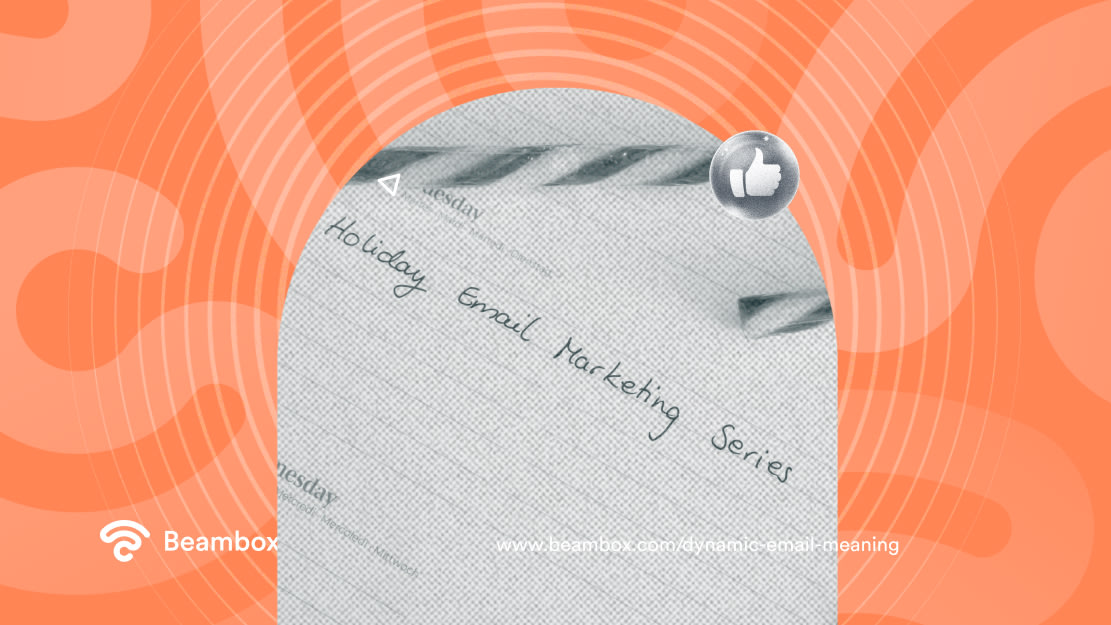These days, brands use tailored content in their emails to attract and engage their target audience. This innovative approach, by the name of dynamic content, is a great strategy to use in email marketing. That’s why “dynamic email meaning” is such a popular query on the Internet.
It’s easy to send thousands of generic emails daily and call it a strategy. However, these emails won’t bring results since people will probably ignore them or block you. The only answer is to personalize your emails and make them resonate with the reader.
Continue reading to thoroughly explore the concept of dynamic email to build a better email marketing strategy.

Dynamic Email Meaning: Let’s Start With the Basics
Dynamic email meaning states that these emails change content based on user behavior, preferences, or real-time data. Instead of sending the same emails to everyone, you can personalize them to include specific content relevant to individual recipients.
Dynamic content often becomes the sole difference between a closed sale and a lost deal. After all, why would a person pay attention to a message that has nothing valuable for them? They’ll only open and read an email that feels like you wrote it specifically for them.
For example, you can make changes according to names, addresses, preferences, or customer behavior.
In this context, behavior means customer experience and interaction with your products or services. For example, you can start an email for customers looking for discounts on a specific product as follows:
“Hi [Recipient’s Name], we noticed you’ve been waiting for a big discount on [Product.]”
Here, using the customer’s name instead of a simple “Hi” or “Hello” makes the customer feel valued and sparks interest.
You can also add location, age, or other relevant data. This creates segment-specific content that targets groups of the same age, gender, or preferences. For example, you can email all female subscribers about “pink sneakers.”
Then, there’s another type of dynamic email that uses time-based content. It changes content depending on when a subscriber opens the email and relies on countdown timers or scheduled daily updates.
Unlike dynamic emails, static ones have generic content or information about a product or service. They remain the same for every customer, making them non-interactive. These will go unnoticed.

Email Elements You Can Personalize for Dynamic Email Campaigns
The main goal of sending dynamic emails is to engage your subscribers. To that end, you must consider specific elements that make your content more appealing and personalized.
Visuals are one of the most used elements in dynamic content. They’re more attractive to the human eye than simple text. That’s why marketers mostly rely on dynamic images to stand apart.
For example, you can personalize an image by using age or gender. Use more vibrant colors for young subscribers and monochrome for older ones.
Another dynamic element is the subject line. A catchy subject line will encourage subscribers to open and read the email. Moreover, it has the potential to turn a wandering lead into a paying customer, so pick it wisely.
After the subject line comes the actual content, which you can make as dynamic or static as you want. For example, keep the greeting the same for all customers but change the recommendations.
Use the most recent subscriber actions, such as clicks on a specific product, newsletter, or blog. For instance, if you have an entertainment blog, you can send personalized emails to subscribers according to their favorite genre. Medium is an excellent example of creating personalized blog emails.
Additionally, customizing the call-to-action (CTA) effectively accelerates click-through rates. For example, you could say, “Complete the purchase before it’s too late” for unpurchased items in the cart.

5 Benefits of Dynamic Emails That Make Them Worthwhile for Businesses
According to statistics, 64% of people base their decision to open or delete emails on their subject lines. Your emails will probably land in the trash if your subject lines aren’t dynamic.
The same is true for other elements of your email marketing campaigns. However, if you still have doubts, the following benefits encourage you to give it a chance.
- Increases customer’s trust: Dynamic emailing speaks to the customers in their language. It makes the subscriber believe you understand their needs and requirements, building trust.
- Improves email engagement: A dynamic email campaign focuses on the recipient, making them more likely to engage with it.
- Convert leads into customers: Showing customers their desired product increases their chances of buying it. All you have to do is monitor their recent behavior or purchases.
- Earning loyalty: When customers feel that a brand understands them better than others, they return.
- Saves time: Dynamic emails usually have placeholder text that you can customize according to each individual. Hence, you can target more people at the same time without creating the email from scratch.
How To Create a Dynamic Email Campaign in 5 Easy Steps
Now that the meaning and importance of dynamic email is clear, let’s jump to the next step. Creating a dynamic email may seem tricky, but it’s not. All you have to do is keep tabs on your subscriber’s data and use your creative imagination.
Make dynamic email the focus of your marketing, and it will never disappoint you. If you think you can’t create an engaging message, the following steps will help you craft the perfect dynamic email.

The first step to creating a dynamic email is finding an amazing tool to make the process effortless. Do your research and choose tools that include drag-and-drop editing. This feature allows you to customize email templates by simply dragging text, images, and other elements into them.
Moreover, a good email marketing tool should let you automate your emails according to subscriber actions. Alternatively, you can automatically send these emails according to a set schedule.
Having tools that offer innovative features for dynamic content saves time, so you can focus on what matters. It also ensures your email seizes the day with personalized content. However, don’t ignore your budget in this process, and ensure the tool aligns with your specific needs.
2. Collect Customer Data
Dynamic emails rely on customer data for segmentation and personalization. After all, how will you customize the emails if you don’t know your customers?
For that, people share basic data such as name, email, location, and age when visiting websites or signing up. This data is valuable in shaping your email marketing strategy.
You can also integrate sources like your CRM with the marketing tool to pull the data in real-time. Alternatively, you can collect relevant data using surveys, sign-up forms, or by analyzing your website’s data.
Feedback forms are another great way to understand your customers’ interests. However, when collecting customer data, be mindful of compliance, privacy, and data regulation laws.

3. Segment Your Email List
Marketers who want to send dynamic emails spend extra time segmenting their email lists. If you want your emails to bring the results you want, you must follow in their footsteps. You can divide your subscribers into groups according to their demographics, preferences, or actions.
You can also create segments, such as free or premium, depending on the membership level. But why does this even matter?
Segmentation helps you create a more targeted approach to sending dynamic emails. Remember, your subscribers only want to read emails that align with their interests.
4. Plan the Email and Its Content
If you’ve followed the previous steps religiously, creating the email shouldn’t be a problem. So, move on to create an email design that aligns with your subscriber.
Add content blocks first and then decide where to add the dynamic elements. This way, you won’t have to confuse the dynamic content with the static one. For example, you may only want to customize the subject line or CTA. However, ensure that the type of content agrees with the content blocks.
Moreover, use email templates according to the segmentation and add dynamic data as you need. This is more time-efficient than creating an email from scratch.

5. Create Conditional Logic for Personalization
Personalizing an email requires a few actions that help relevant content land in your subscriber’s inbox. The term dynamic email marketing means enabling personalized experiences for your subscribers. You can implement this using conditional logic like “if” and “then.”
First, specify the “if” section of the logic. It works as a trigger that decides the content of the recipient’s email. For example, if customers subscribed recently, are opening discount emails, or aren’t using your services anymore.
Next, you can create the “then” part, making the content specific to the subscriber’s interest. For example, you can offer a premium service, send promotional emails, or a special offer.
Enable Dynamic Email Meaning in Gmail
Dynamic email Gmail meaning.is similar to the ones discussed so far. Dynamic emails in Gmail allow users to take action by using links. Receivers can visit a website, fill out forms, and browse products without leaving the email.
These emails work on the Accelerated Mobile Pages (AMP) protocol and are convenient for both senders and recipients. Businesses add links to their retail stores or blogs. Clicking those links redirects the subscriber while keeping them in the Gmail inbox.
However, you must register with Google to send these emails. To do so, you must fulfill the requirements, such as filling out the registration form, meeting the guidelines, etc.
Furthermore, receivers must familiarize themselves with the meaning of “enable dynamic email.”
They must enable or disable dynamic emails from their Gmail settings. To do this, they simply have to click on the Settings icon, scroll down to Dynamic Email, and make the changes.

Frequently Asked Questions About Dynamic Email Marketing
Dynamic email is a vast subject with many questions that need answers. So, let’s take a look at common queries.
What does dynamic email mean in Gmail?
Dynamic email in Gmail means receivers can use the inserted links or click buttons to visit the website pages.
It’s hectic to read about a discount on Gmail and then visit Google to search for the sender’s website. However, dynamic email in Gmail effortlessly removes this barrier.
What does dynamic email mean?
Dynamic email addresses each customer separately. It uses customer data such as name, email, address, and website history to send personalized content and increase email engagement.
For example, subscribers can get emails about their latest interest or purchase history.
What is the difference between a static and dynamic email?
The difference between a static and dynamic email lies in the content. Static email content doesn’t change according to the subscriber’s data, while dynamic email content does.
Moreover, static emails are generic and provide the same information to all the receivers. On the other hand, dynamic emails speak to the recipient’s interests.
Shift From Static to Dynamic Emails for Better Personalization
Knowing the dynamic email meaning will help you shine in your subscriber’s inbox. With the rise of bulk information and short attention spans, replacing general information with personalization is best.
Doing so can increase loyal customers, boost conversions, and build your brand in no time. Combining email marketing with WiFi marketing gives you an advantage in ensuring your establishment’s solid footing.
With Beambox, you can leverage email marketing and make more sales. Beambox is helping over 12,000 venues to grow and scale their business. Do you want to be next? Start your trial today!